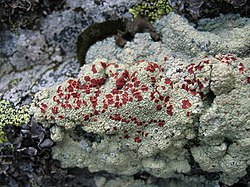| Ophioparma ventosa | |
|---|---|
 | |
| Scientific classification | |
| Kingdom: | Fungi |
| Division: | Ascomycota |
| Class: | Lecanoromycetes |
| Order: | Umbilicariales |
| Family: | Ophioparmaceae |
| Genus: | Ophioparma |
| Species: | O. ventosa |
| Binomial name | |
| Ophioparma ventosa | |
Ophioparma ventosa is a species of lichen belonging to the family Ophioparmaceae. [1]
It has cosmopolitan distribution. [1]
Synonym: